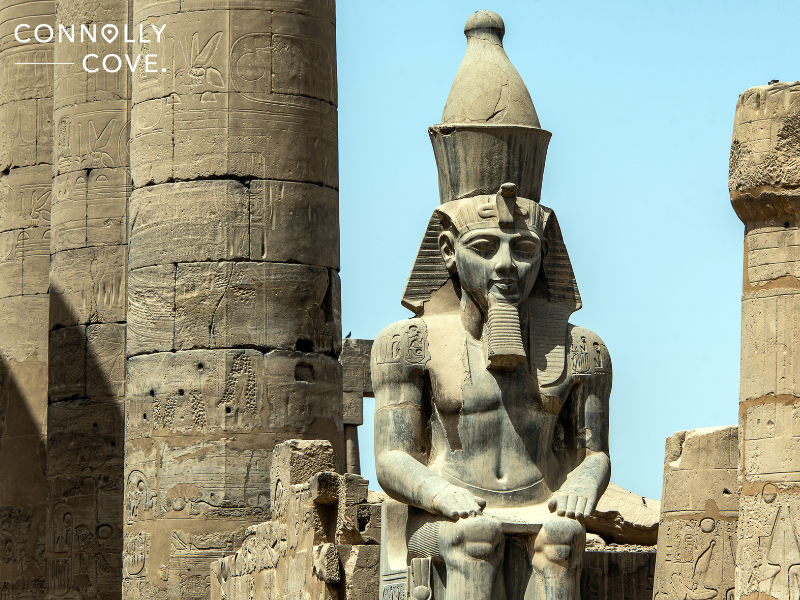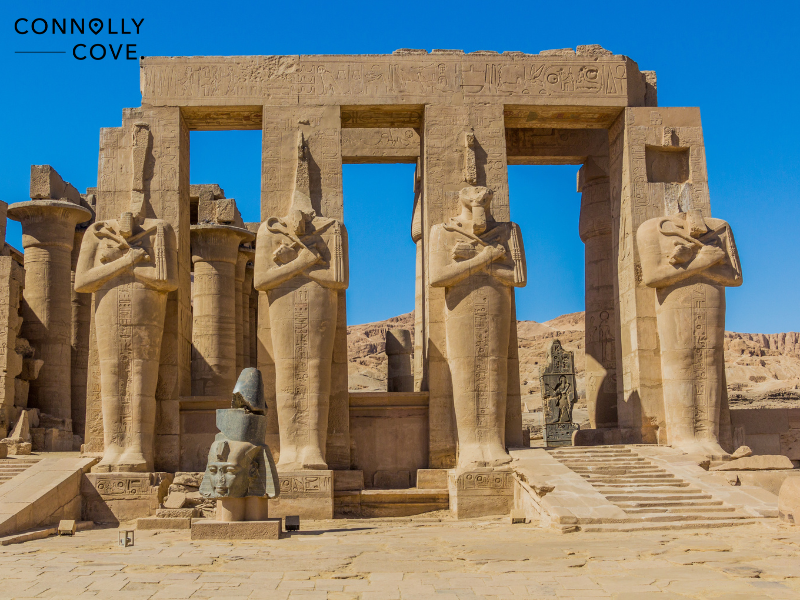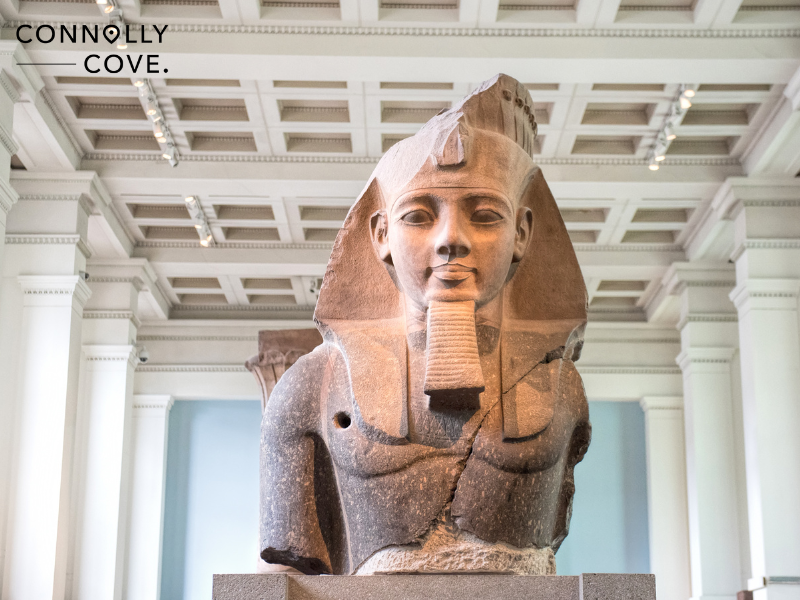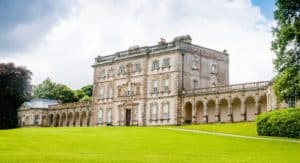The Ramesseum: Exploring Ramesses II’s Enduring Legacy

Updated On: May 01, 2024 by Noha Basiouny
Somewhere in the desert, not that far away from the remarkable Valley of the Kings, the magnificent Mortuary Temple of Hatshepsut, and many other whispering giants, stands another monumental testament to the might, grandeur and architectural prowess of ancient Egypt—the Ramesseum.
Built by Pharaoh Ramesses II, the Ramesseum, which dates back to the 13th century BC, serves as a religious sanctuary dedicated to both the powerful ruler and the sun god Ra. It is characterised by its towering pylons, colossal statues, expansive courtyards, intricate hypostyle hall, and comprehensive hieroglyphs that narrate the pharaoh’s military triumphs and divine connections and pay tribute to the everlasting spirit of Egyptian civilisation.
In today’s story, we are taking you on a journey back in time to shed some light on this monumental temple complex, which is a key component of the funerary landscape on the west bank of the Nile and one that played a crucial role in the religious and ritualistic practices of ancient Egypt.
So, let’s hop into it.
Ramesses II

Before we set off exploring the Ramesseum, we need to learn a thing or two about the very pharaoh who made this architectural marvel possible in the first place, King Ramesses II.
Ramesses II is one of the greatest, most powerful and celebrated pharaohs of all time. He reigned during the New Kingdom, which itself is the most prominent period of ancient Egypt and the last of three golden ages of this magnificent civilisation.
In 1976, the mummy of Ramesses II was sent to Paris for an eight-month restoration procedure before it was brought back home. The king rested in the Egyptian Museum in Downtown Cairo for several decades, and then he, among 21 other pharaohs, was moved to the National Museum of Egyptian Civilisation in Egypt’s striking golden parade of 2021.
In 2023, the mummy of Ramesses II returned to Paris on a particular loan for a phenomenal exhibition.
Ramesses II had many wives, though his most beloved one was Queen Nefertari, for whom he built one of the largest and, by far, the most lavish and vividly beautiful tomb in the Valley of the Queens. The king had over 100 children, many of whom he already outlived. In 1213 BC, Ramesses II died aged 90 and was buried in the Valley of Kings.
Military Achievements
Like his father, Ramesses II was a fearless army leader renowned for his military achievements. He was involved in fortifying Egypt’s borders and constructing a series of military installations and defensive structures to protect the kingdom from potential invasions. He also conducted numerous military campaigns against various adversaries, including the Libyans and Nubians. His exploits expanded the Egyptian Empire and reinforced its dominance in the ancient Near East.
Yet, Ramesses II is best known for fighting the Hittites, who had long been a threat to the Egyptian state. Thanks to his strategic skills, he was able to defeat them in the Battle of Kadesh, a very well-documented military engagement and one that resulted in a peace treaty between Ramesses II and the Hittites, the first of its kind in the history of humanity.
Construction Activity
Ramesses II was also an ambitious builder. His long reign during the New Kingdom period witnessed an impressive array of construction projects throughout Egypt that were not only expressions of architectural grandeur but also served political, religious, and propagandistic purposes. They are also believed to have inspired his successors to follow suit and leave an impressive legacy.
So, the king first made significant additions to the Karnak Temple Complex in Thebes, enhancing its precincts with new structures and embellishments. He continued and completed The Great Hypostyle Hall, which had been initiated by his father, Seti I. The hall is known for its massive scale, featuring 134 colossal columns arranged in a grid pattern and rows of towering columns with papyrus and lotus capitals.
Another of his several iconic architectural endeavours is the Temple of Abu Simbel. This structure was carved into the mountainside in Aswan and is famous for its super colossal statues of the king seated on his throne. Ramesses II also erected numerous other colossi to immortalise himself and project his power across the kingdom, such as those at the entrance of the Luxor Temple.
For so long during ancient Egypt, many pharaohs sought to establish a perpetual connection with the divine, so they built mortuary temples dedicated explicitly to themselves as well as various gods. These structures served as places for religious ceremonies, rituals, and offerings that were believed to sustain the deceased pharaoh in the afterlife. Ramesses II was no different, so he commissioned the construction of the Ramesseum.
The Ramesseum
Standing on the west bank of the Nile in modern-day Luxor, or what used to be Thebes back then, the Ramesseum had the primary purpose of honouring the reign of Ramesses II, military victories, and contributions to the prosperity of ancient Egypt. The temple’s walls and reliefs depict scenes of he king’s military campaigns, including the Battle of Kadesh, and various religious ceremonies, emphasising his divine connection and leadership.
The design of Ramesses’s mortuary temple adheres to the standards of the New Kingdom temple architecture. It was a venue with various structures where rituals and offerings were conducted by priests to honour the pharaoh, maintain a connection between the earthly realm and the divine, and ensure his well-being in the afterlife.
The temple was once a grand and imposing structure; however, time and natural disasters have taken their toll on it. Still, its remnants speak volumes about its former glory and the site was even declared a UNESCO World Heritage Site.
So, what exactly did this temple look like?
The Ramesseum is oriented both northwest and southeast. It incorporated two consecutive 60-metre-wide stone pylons or gateways, each leading into a courtyard. Beyond the second courtyard, at the very centre of the complex, was a covered hypostyle hall comprising 48 columns surrounding the inner sanctuary. The innermost part of the temple was the sanctuary, dedicated to rituals and offerings for the pharaoh’s afterlife.
The Ramesseum complex also included a smaller temple dedicated to Ramesses II’s mother, Queen Tuya, a birthing house, and a sacred lake.
Now that we have taken a general look at the Ramesseum, let’s identify some of its most prominent structures.
Colossal Statues
The entrance to the Ramesseum used to be flanked by two colossal granite statues of Ramesses II, each reaching a height of around 18 metres. Though now collapsed, these massive sculptures were strategically positioned to create a sense of awe and reverence for those approaching the temple. They were also so meticulously crafted to capture the likeness of Ramesses II.
The colossal statues also carried profound religious symbolism. The pharaoh was considered a living god, and these statues embodied his divine nature, depicting him, both when young and old, in a traditional pose with one foot forward and symbolising his eternal presence and readiness to stride into the afterlife.
Along with many structures in the temple, the two statues unfortunately collapsed sometime in history. The bust of the younger statue, called the Younger Memnon, can now be found at the British Museum in London, while the remaining parts are still at the temple beside the remains of the other statue.
Hypostyle Hall
The Hypostyle Hall at the Ramesseum is a large and impressive architectural feature, characterised by a roof supported by numerous columns like that at Karnak. This hall of the Ramesseum stands as a living testament to the architectural and artistic genius of ancient Egypt.
The towering columns are typically arranged in a grid pattern, creating a large open space beneath the roof. Each of them is intricately carved and topped with capitals designed to resemble bundled papyrus plants. They are also adorned with carvings and reliefs depicting scenes from Ramesses II’s military campaigns, religious rituals, and offerings to the gods. These decorations served to glorify the pharaoh and immortalise his achievements.
Osiride Statues

An Osiride statue is usually one of a pharaoh standing cross-handed like a mummy with his back leaning against a wall or a column. This mummiform posture is actually a depiction of Osiris, the ancient Egyptian god of the deceased, so as to emphasise the pharaoh’s association with death and resurrection.
At the Ramesseum, there are four Osiride statues, all of which depict Ramesses II.
The Osiride statues are strategically placed in the second courtyard, creating a sense of symmetry and balance. Their alignment with the temple’s axis and other architectural elements reinforces the meticulous planning and design principles of ancient Egyptian architects.
The courtyard, adorned with these god-like statues, hence became a ceremonial space where religious rituals and offerings were likely conducted to honour the pharaoh’s divine essence.
Excavation
The Ramesseum, like many ancient Egyptian archaeological sites, has undergone various periods of excavation and exploration by researchers and archaeologists seeking to uncover its history and significance.
The earliest exploration of the Ramesseum goes as far back as Napoleon’s Expedition in Egypt at the end of the 18th century, which, apart from its colonial objectives, took a considerable interest in Egyptian civilisation. This interest was best represented by the 22-volume publication the “Description de l’Égypte,” which described and documented, both in words and illustrations, Egyptian antiquities, the country’s flora and fauna, as well as society in unprecedented detail.
The second exploration of the Ramesseum was made by the Italian showman and later archaeologist Giovanni Belzoni. He came to Egypt in 1815, where he met the British Consul General Henry Salt and went on an expedition to the Ramesseum at the latter’s wish. As it turned out, this trip was not about studying the country’s history or marvelling at the ingenuity of ancient Egypt but was, in fact, a systematic robbery.
Belzoni was a skilful engineer, and Salt thought he could commission him to move the seven-tonne bust of Ramesses II’s younger statue at the Ramesseum, the Younger Memnon, using the hydraulic engine he invented to facilitate transporting it to England. Belzoni apparently succeeded in his mission, given that the king’s bust has been residing at the British Museum since 1817.

Starting the 20th century, more and more expeditions set off to explore the site despite its deteriorating state. Efforts have been made to stabilise and conserve the remaining structures, and conservation projects aim to protect the site from further decay and ensure its preservation for future generations.
The Ramesseum Magician’s Tomb Box
Also called the Tomb 5 box, the Magician’s tomb box is a fascinating archaeological discovery made at the Ramesseum, offering a glimpse into the world of magic and medicine during the Middle Kingdom. It is basically a 45.75*30.5*30.5 cm wooden container that was discovered in 1885-1886 by archaeologists Flinders Petrie and James Quibell while excavating a tomb beneath the temple.
Though called the Magician’s tomb box, it was not found in a proper tomb but rather in a smaller storage chamber associated with a larger tomb structure. This uncertainty fuelled debate about its original owner and purpose. The location of this larger tomb, however, is currently unknown, for it could not be identified using the map James Quibell drew of it.
The box held a rich collection of objects related to magical practices. For instance, around 60 papyri with diverse content, including medical/magical texts, ritual instructions, hymns, and even literary snippets, were found inside of it. These shed light on ancient Egyptian magic and religious beliefs. Reed pens were also found, suggesting the box belonged to someone who could read and write, possibly a priest or magician.
Unfortunately, about one-third of the papyrus scrolls were not preserved, leaving gaps in our understanding of the texts and rituals.
Other components include ivory wands, a wooden figurine of a woman with lion features, an ivory figure of a boy carrying a calf, a bronze Uraeus wand entangled in hair, and various miniature charms and beads. These likely served as tools for performing rituals and spells.
While significant, the box continues to be studied and interpreted, with new discoveries and insights emerging through ongoing research and analysis.
The Ramesseum stands as a gigantic demonstration of the enduring legacy of Pharaoh Ramses II and the remarkable achievements of ancient Egyptian civilisation. Its colossal statues, intricate reliefs, and sacred spaces continue to capture the imagination of visitors, history enthusiasts, and Egyptologists, offering a glimpse into a bygone era of splendour and reverence.
As we leave the Ramesseum with its shadows lengthening in the desert sun, we are reminded that the human spirit, in its yearning for transcendence and its struggle with mortality, remains remarkably constant across the vast gulf of time.






